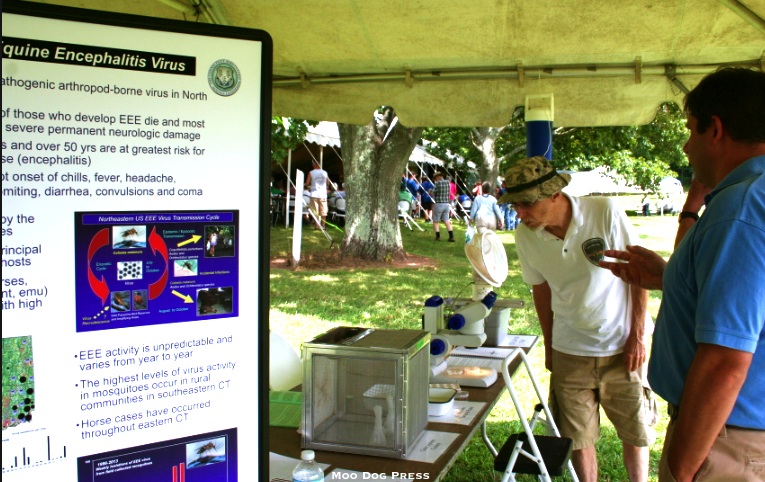EEE: 2016
Head's up for EEE if you ride or hike in Voluntown an/or Pachaug State Forest.
The State Mosquito Management Program reports that mosquitoes trapped in Voluntown on Sept. 12, 2016 have tested positive for eastern equine encephalitis (EEE) virus. This represents the first sample of EEE-positive mosquitoes identified in the state by the Connecticut Agricultural Experiment Station (CAES) this season.
In addition, West Nile virus (WNV) infected mosquitoes have been identified in 20 Connecticut towns: Bridgeport, Cromwell, Darien, East Haven, Easton, Fairfield, Hartford, Manchester, Milford, New Britain, New Haven, Newington, Stamford, Stratford, Wallingford, Waterford, West Hartford, West Haven, Westport, and Wethersfield.
“Although mosquito populations are declining, the detection of EEE virus requires continued monitoring,” said Dr. Philip Armstrong, Medical Entomologist at the CAES. “This is the first detection of EEE virus in mosquitoes since 2013 when a human fatality occurred in that same region of Connecticut.”
“Mosquitoes are still active, and EEE and West Nile virus continue to be detected in the state” said Dr. Theodore Andreadis, Director of the CAES. “I encourage residents to take measures to prevent mosquito bites, such as using insect repellent and covering bare skin, especially during dusk and dawn when mosquitoes are most active.”
Eastern equine encephalitis is a rare but serious viral disease in people. On average there are 6 human cases each year in the United States. The mortality rate of hospitalized patients is one-third and approximately one-half of people who survive infection suffer from permanent neurological damage. In Connecticut, outbreaks of EEE have occurred sporadically in horses and pheasants since 1938 and the first locally-acquired human case was reported in the fall of 2013.
West Nile virus is the most common mosquito-borne viral disease in the United States and reemerges every summer in Connecticut. Since 2000, 131 human cases of WNV-associated illnesses including 3 fatalities have been confirmed in the State.
The State of Connecticut Mosquito Management Program is a collaborative effort involving the Department of Energy & Environmental Protection, the Connecticut Agricultural Experiment Station, the Department of Public Health, the Department of Agriculture, and the University of Connecticut Department of Pathobiology and Veterinary Science. These agencies are responsible for monitoring the potential public health threat of mosquito-borne diseases.
The CAES maintains a network of 91 mosquito-trapping stations in 72 municipalities throughout the state. Mosquito traps are set Monday – Thursday nights at each site every ten days on a rotating basis. Mosquitoes are grouped (pooled) for testing according to species, collection site, and date. Positive findings are reported to local health departments and on the CAES website at http://www.ct.gov/caes/mosquitotesting.
Have there been any horse cases of EEE in Connecticut?
Horse cases occur sporadically in Connecticut and is believed to have occurred among horses as far back as 1928 when there was a severe outbreak in New London County with about 100 cases. Symptoms of may include appetite loss, drooping eyelids and lower lip, aimless wandering and circling, blindness, and inability to stand. The infection is fatal to horses in more than 90 percent of cases, and death usually occurs in two to three days. A vaccine is available for use in horses.
How is EEE spread?
Mosquitoes spread the EEE virus. The virus is carried by birds that live in freshwater swamps and is generally found only in these birds and in mosquitoes that feed on birds but not people. In some years however, many birds get infected and other types of mosquitoes pick up the virus that also bite people and horses. The risk of getting EEE is highest from late July through September. The virus is spread by adult mosquitoes, which are killed by frost in the fall. The EEE virus is not spread by people and horses with the disease.
For more information see this link to the official CT.gov page about mosquito management.
Note: The Connecticut Agricultural Experiment Station (CAES) traps, identifies, and tests mosquitoes for encephalitis viruses. More than 25 scientists and support staff conduct the statewide surveillance program. During 1999, station scientists were the first to culture and characterize the West Nile encephalitis virus from mosquitoes collected in North America.
They also have identified the major mosquito vectors of West Nile virus in Connecticut. In addition, Station scientists found that the American robin is a favorite host for some mosquitoes and is an important carrier of the virus. Other findings revealed that Culex salinarius, a mosquito that breeds in brackish and fresh water, is the probable “bridge vector” moving the virus from birds to mammals. Of the top 100 science stories of 2005, Discover Magazine (January 2006 issue) ranked these recent discoveries at #43. Other results indicating the presence of Potosi and La Crosse viruses in the state represent new records for New England.
State of Connecticut Zika Virus Surveillance and Response Plan 2016 (PDF), linked here.

